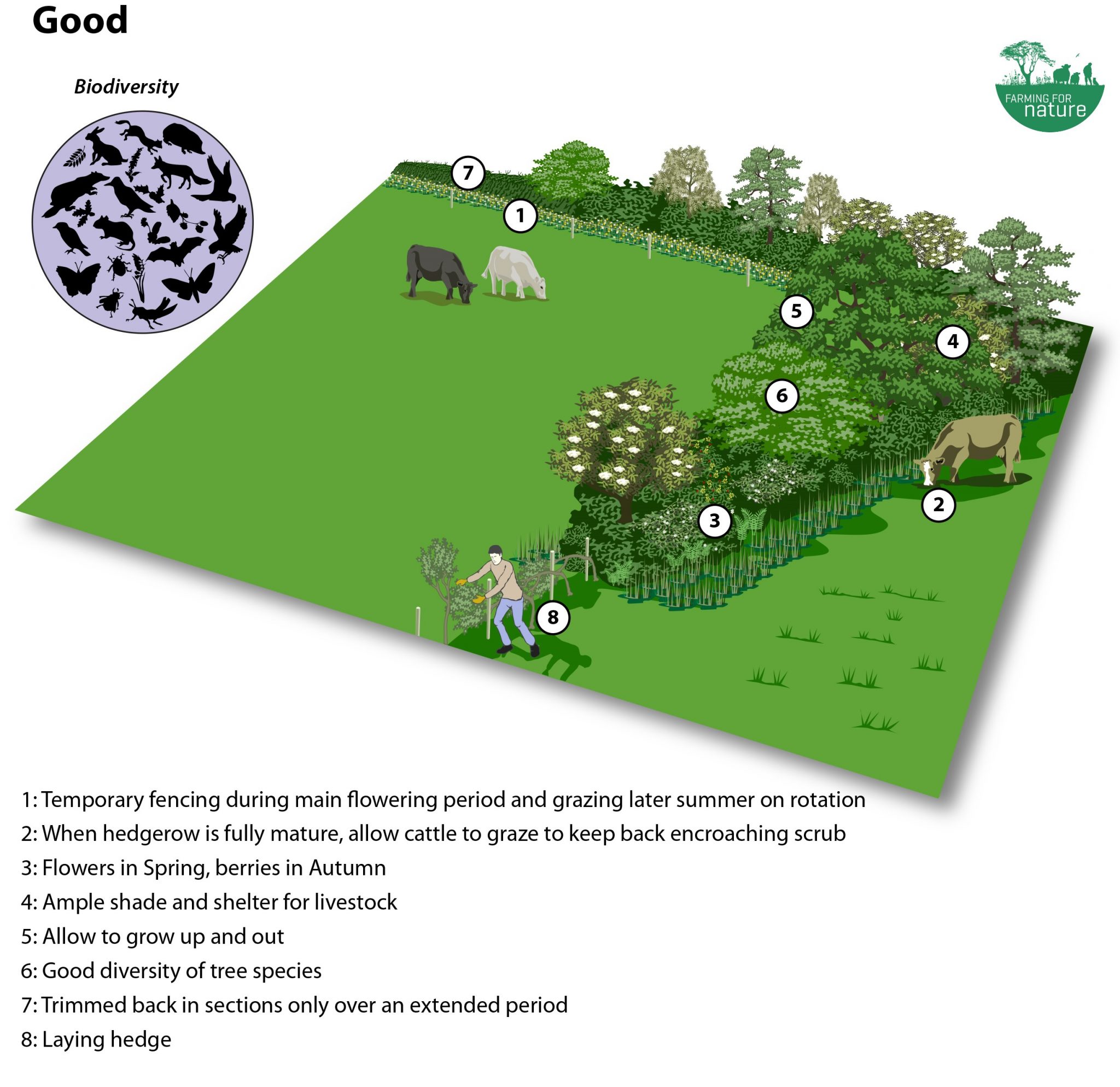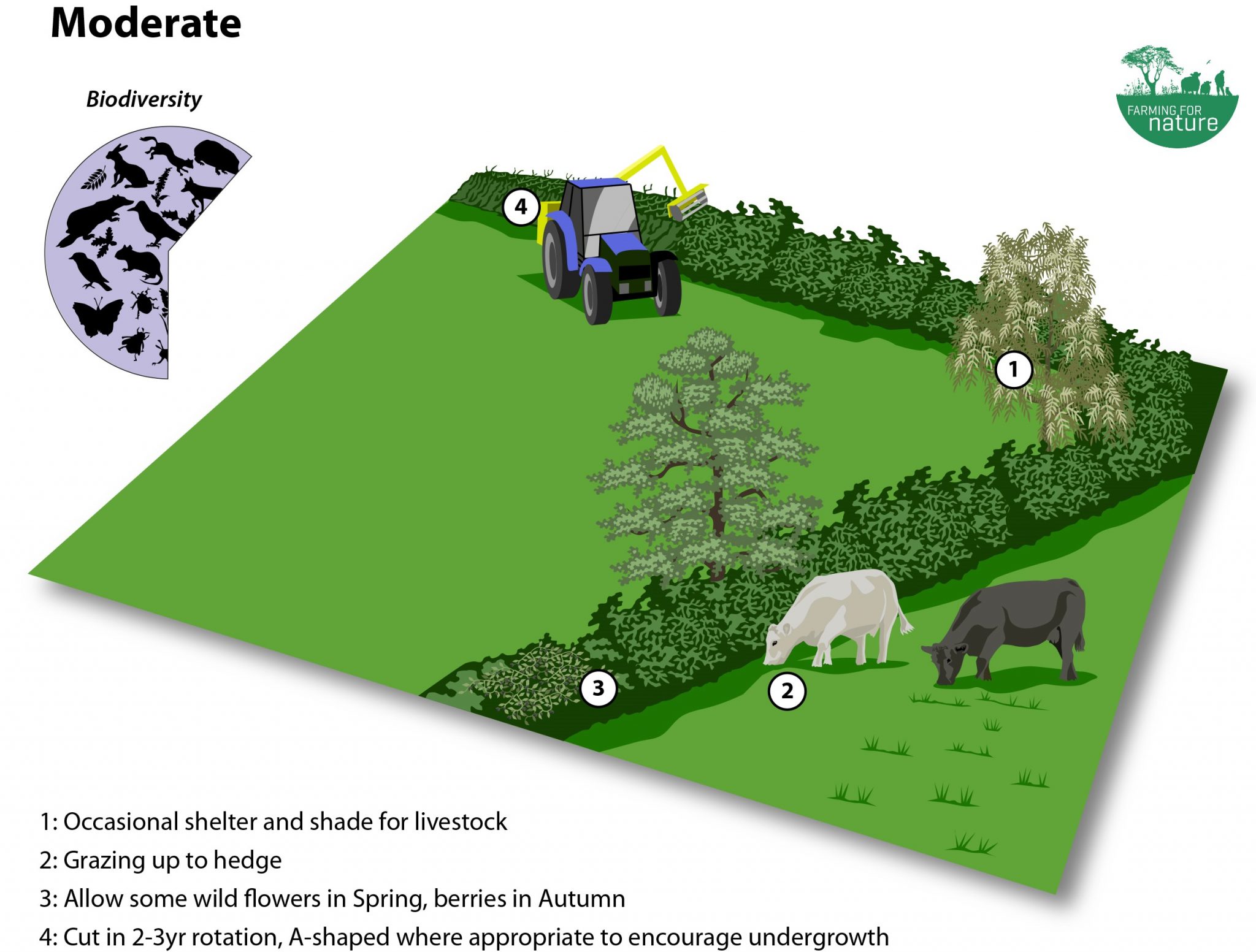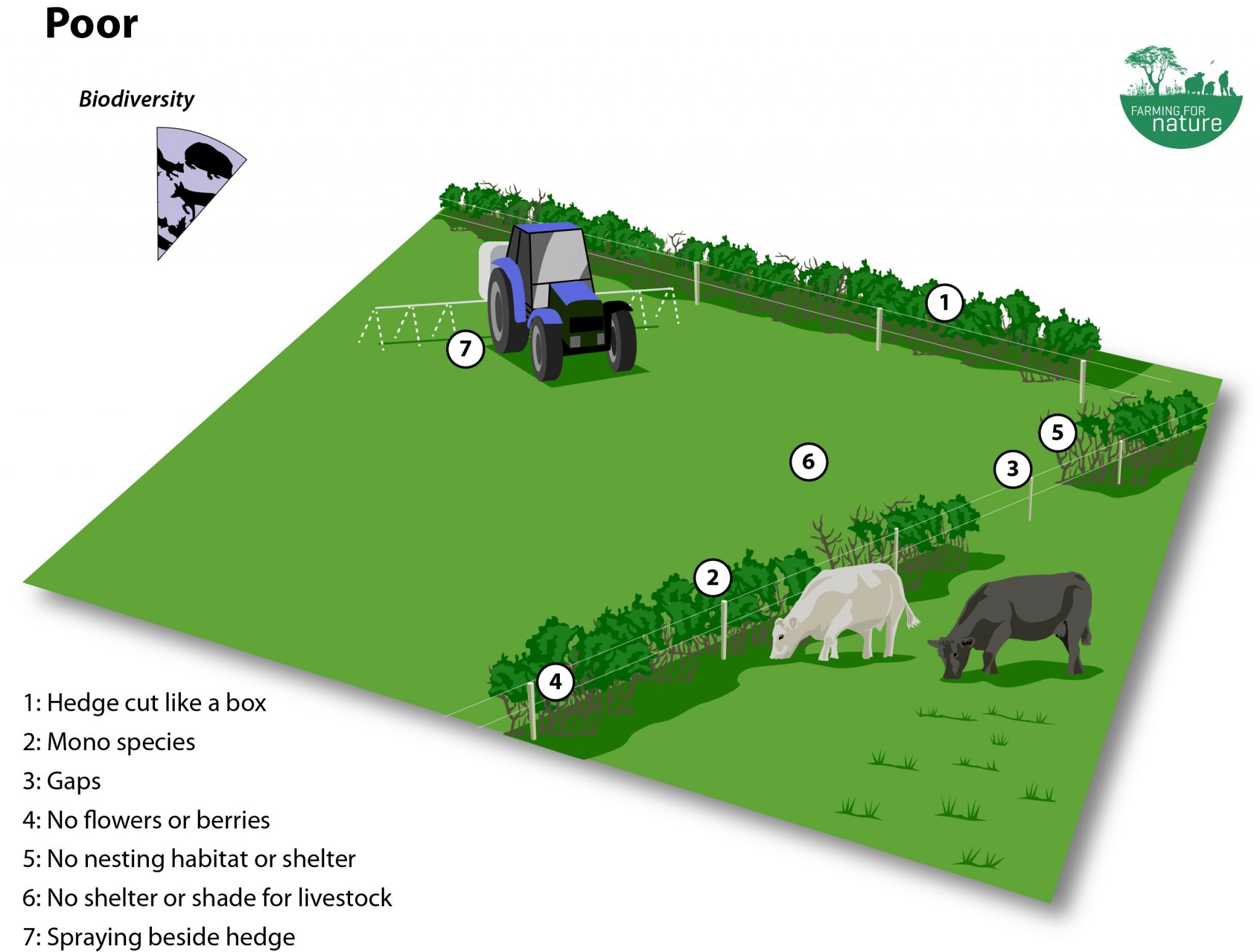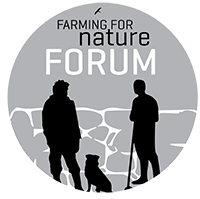Best Practice Guidelines
VIEW & PRINT AS HEDGEROW LEAFLET HERE
Hedgerow management
Why should I look after my hedgerows?
Agricultural Benefits: Hedgerows can provide shelter and shade for livestock, prevent soil erosion, and help reduce agricultural runoff reaching rivers and causing pollution. They can help improve soil health and vegetation growth, providing additional forage for livestock. As useful natural boundaries, they can also help limit the spread of disease.
Ecological Benefits: Hedgerows contain a wide variety of plant species, from trees to shrubs to flowers. They host a variety of wildlife including birds, small mammals, and many insect species including pollinators such as bees and hoverflies. As such they act as homes, larders and corridors for wildlife – they can provide food, water and shelter, are an ideal place for nesting and resting, and allow wildlife to move safely between otherwise isolated habitats.
Climate Benefits: Good hedgerows are very effective at capturing Carbon. Some researchers estimate that hedgerows and non-forest woodlands could potentially sequester 0.66–3.3 t CO2/ha/year! Hedgerows can also help offset some of the anticipated impacts of climate change by providing shade and shelter from weather extremes.
| Examples of native shrubs and trees for hedgerows:
Hawthorn, Blackthorn, Hazel, Holly, Elder, Guelder Rose, Crab Apple, Alder Buckthorn, Spindle, Dogwood, Rowan, Bird Cherry, Wild Cherry, Scots Pine, Downy Birch, Oak, Grey Willow, Whitebeam. |
What do well-managed hedgerows look like?



Getting Started:
- Begin by carrying out a simple assessment of your field boundaries. Where are they (draw a simple map), what are they (hedgerows, stone walls, embankments, wire/posts) and what condition are they in?
- Try to assess what species your hedgerows currently contain (trees, shrubs, flowers, mammals, birds etc) and also identify areas (gaps etc) where you could improve the condition of the hedgerow.
- Ideally, established hedgerows should be left grow upwards and outwards so it’s really as case of doing less – maybe mowing any vegetation that is pushing too far out into the field every Autumn or trimming back the sides a little where they are becoming too unruly, but very little else.
- For hedgerows in poorer condition, fill gaps in hedges by planting diverse native species – preferably locally sourced. Or consider coppicing or laying the ‘leggy’, gappy areas. If livestock are causing a lot of damage, maybe fence them back until the hedgerow is more established and resilient.
- If planting a new hedge, do so in winter. Try to connect the new hedgerows to other natural features as this may help support the spread of wildlife into the new hedgerow. New hedgerows will require pruning to stimulate fresh, bushy growth for the first 3-5 years until they become dense and established.
Further Actions:
- The ideal hedgerow for wildlife is tall, wide and dense at the base, with a wide, uncultivated, grassy margin. Such hedgerows really are ‘networks for nature’.
- The most important action is often to nothing – at least for a while – as some hedgerows just need to left in peace a little more! Over time however, you may find that unless you have animals grazing occasionally at the base, the hedgerow will encroach into the field with blackthorn suckers and bramble and these will need to be trimmed back with a mower when they are young, before they become established.
- When planning hedgerow management, tailor the management to suit the hedgerow. Tall hedges with plenty of trees should be given just a side trim, hedges with wide grass or wildflower margins and short hedges without trees are better cut in ‘A-shape’ so the broad base allows light and encourages a dense growth at a ground level which is better for ground-nesting birds. In all cases, try to allow trees to reach their full potential at intervals, including thorns. The more diversity the better – manage in a landscape context rather than just an individual hedgerow context, the wider field boundary network of drainage ditches, banks and stone walls will provide a wide variety of habitats for a range of species.
- Avoid cutting all your hedgerows at once, consider a 3-5 year rotation to allow flowers and berries to grow in alternate sections. Gradually reduce cutting intensity each year to allow your hedgerow to expand and diversify. This is especially relevant for the young hedges which are just getting established.
- Where there is a row of trees with a dense canopy but the hedge is gappy at the base, consider cutting back sections here and there to allow more light in and therefore encourage greater diversity – honeysuckle, vetches and other smaller flowers will hopefully move in and enhance the diversity present.
- Hedgerow cutting is usually undertaken with a flail, but a circular saw is a less damaging alternative which results in a cleaner cut and encourages better re-growth.
- If planting a new hedgerow, consider ‘banking’ it like the old hedgerows; this creates more than one habitat.
- Delay trimming as late as possible – maybe until January and February (though make sure the ground isn’t too wet/soft) as the surviving berry crop will provide valuable food for wildlife.
- Similarly, allow the hedgerow bases and other field margins to flower and set seed before cutting – this may require some fencing, consider 2m out, during the main flowering period (May-July).
Avoid
- Avoid over-management; tightly cut hedges mean there are fewer flowers and berries, thus reducing available habitats, feeding sources and suitable nesting sites.
- Avoid cutting hedgerows between March and August inclusive. It is both prohibited (except under certain exemptions) and very damaging for wildlife particularly in terms of food and habitat value.
- Avoid removing hedgerows, even the dying ones – where they are not a hazard or they don’t prevent younger trees from growing, retain them as they may support insect communities, bat roosts and cavity-nesting birds.
- To prevent livestock from damaging new and existing plants, especially between May and July, fence up to 2-meters out from the hedgerow base. Avoid grazing or cutting the base/margins until after the main flowering period i.e. August.
- Avoid using sprays or fertilisers near hedgerows as they can have an extremely negative effect on the variety of plants and animals that live there.

